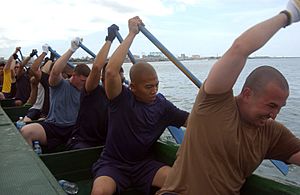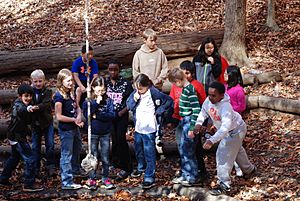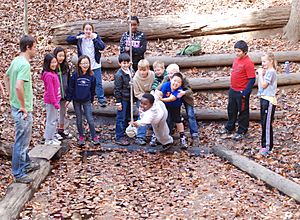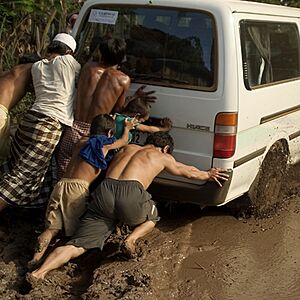Teamwork facts for kids
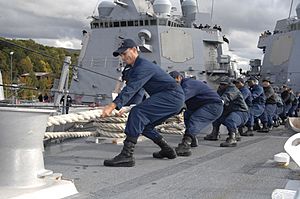
Teamwork is when a group of people work together. They join forces to reach a shared goal. Teamwork helps people understand each other better. It also builds strong friendships. Working as a team helps get any job done the right way. For example, in health care, doctors and nurses use teamwork. They work together to help patients at the hospital. Every team member has a specific job to do. In teamwork, everyone shares the work.
Teamwork is the effort of a group of people. They work together to achieve a common goal. They also complete a task in a good and fast way. Teamwork happens within a team. A team is a group of people who depend on each other. They all work towards the same goal.
Contents
History of Teamwork
The word "teamwork" has been used for a long time. The Oxford English Dictionary shows it was used as early as 1800. Back then, it described animals like horses working together. They would pull a cart as a team.
What Makes a Team Work Well?
For a team to work well, it needs certain things. These things help the group succeed.
Sticking Together
A strong team has good group cohesion. This means the team members stick together. When a group is united, they usually perform better.
Good Communication
Communication is very important for good teamwork. Team members must talk to each other clearly. This helps them solve problems and avoid confusion. Good communication also makes the team stick together more.
Having a Common Goal
Communication helps everyone know the team's purpose. This creates a common goal. When everyone aims for the same thing, they help each other. This also makes the team more united.
Being Committed
Commitment means team members are focused. They work hard to reach the team's common goal. Everyone tries their best to help the team succeed.
Being Accountable
Accountability is needed to make sure tasks get done. It also ensures all members are doing their part. When members are held accountable, they become more committed to the team.
How to Improve Teamwork
You can make teamwork better through special training. This training helps both individuals and the whole team. Bruce Tuckman created a model for how teams grow. It shows different stages of a team's life.
Forming Stage
This is the first stage. Team members are new to each other. They might be unsure about working with others. They tend to be careful and avoid taking risks. Teamwork is usually at its lowest level here.
Storming Stage
In this second stage, team members might compete for power. Conflicts can happen. If teamwork is low, the team might struggle to get past these problems. If they work together well, the team has a better chance.
Norming Stage
This is the third stage. Team members start to feel more united. They depend on each other more. They also try to fit into the team environment. Teamwork levels are much higher in this stage. This makes it easier for the team to work together.
Performing Stage
This is the final stage of team growth. The team feels comfortable working together. Members complete tasks well. They work closely and depend on each other. This stage has the highest levels of comfort, success, and teamwork.
Good and Bad Sides of Teamwork
Sometimes, using teamwork is not the best choice. It can even stop teams from doing their best.
Challenges of Teamwork
- Social loafing: This happens when someone in a group puts in less effort. They do less than they would if working alone. If others work harder, it can cause problems. This leads to the team performing worse.
- Individual tasks: Some jobs are better done by one person. They do not need a team. If a team is assigned an "individual task," members might argue. This can hurt the team's spirit and performance.
- Groupthink: This is when a group wants to agree too much. They want to avoid arguments. So, they might not suggest new ideas. They fear others will reject them. The group measures success by how well they get along. They do not focus on the best decision. To avoid this, teams should have members from different backgrounds. Also, each member should be asked to suggest different ideas.
Benefits of Teamwork
Working in teams can also be very helpful. Here are some good things about teamwork:
- Problem solving: A group of people can bring many different ideas. They can combine views to solve problems quickly. Each team member should share their unique ideas. This helps find the best solution. Teamwork can lead to better decisions, products, or services.
- Healthy competition: Sometimes, a little competition can be good. It can motivate people. This helps the team do even better.
- Building Relationships: Teams that work together often build stronger bonds. This helps members avoid arguments. They get to know each other well. Strong relationships make team members happier. This improves both teamwork and performance.
- Sharing Skills: Every team member has special knowledge and skills. Through teamwork, they can share these. This helps other team members learn and grow. It makes everyone more productive in the future.
- Motivation: Working together can make people more motivated. This is because they feel more responsible for their work. When groups are compared, members try harder. This encourages them to work together.
See also
 In Spanish: Trabajo en equipo para niños
In Spanish: Trabajo en equipo para niños


